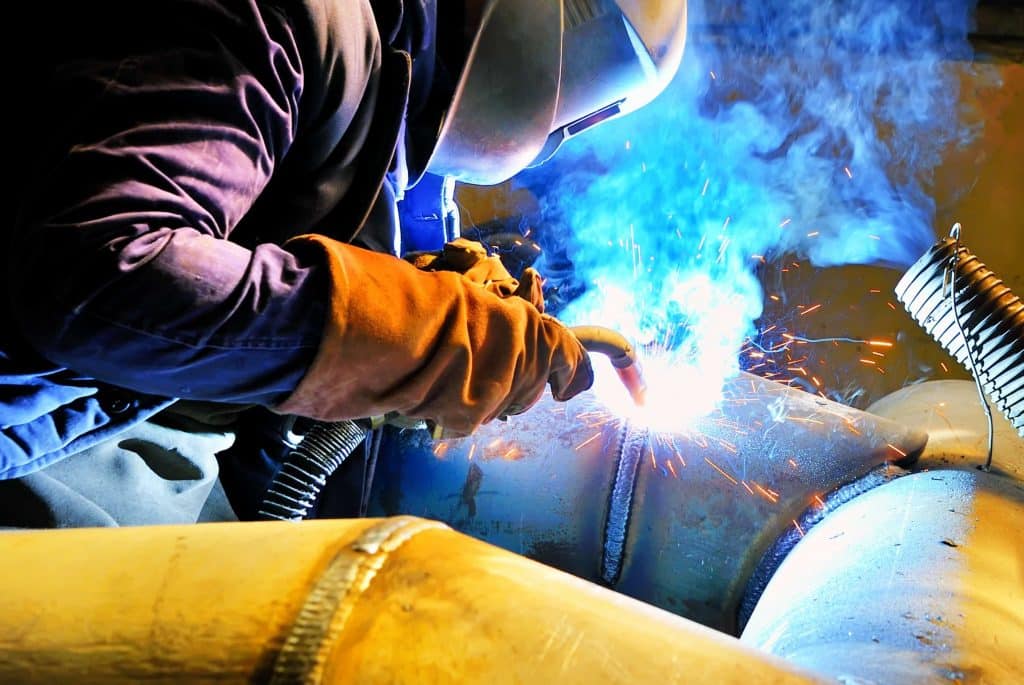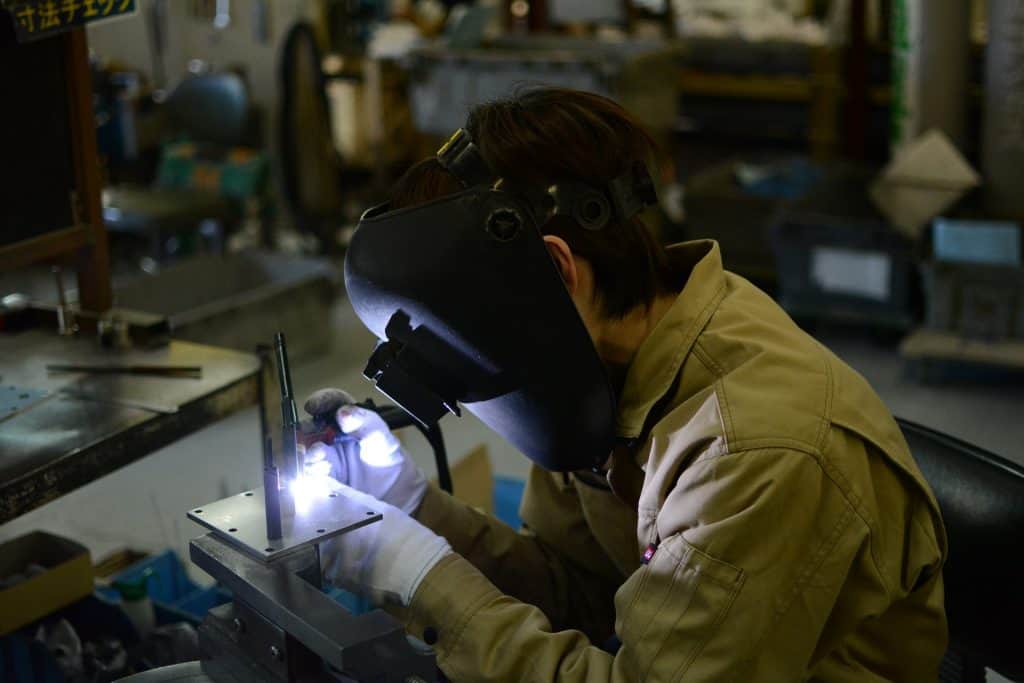Argon is an abundant noble gas with a stable electron structure that allows it to remain unreactive under various conditions. That’s why argon found its way into multiple applications in different industries.
Welding is one of the industries that utilize argon gas. Most commonly, it is used in gas tungsten arc welding (TIG welding) and gas metal inert gas welding (MIG).
![Argon In Welding - [Ar] Shielding Gas Role In TIG & MIG 1 Featured image for argon in welding article](https://weldingpros.net/wp-content/uploads/2022/06/featured-image-for-argon-in-welding-article-1024x563.webp)
In this article, we will discuss how and when to use argon in welding and why it is such a good shielding gas.
Basic Knowledge About Argon Gas (Ar)
Argon gas is a chemical element with the symbol Ar and the atomic number 18. It is the third-most abundant gas in the atmosphere (and the most abundant in the crust). Almost all of the argon found in the atmosphere is radiogenic argon-40, and, in space, the most common argon isotope is argon-36. Industrial argon is extracted by the fractional distillation of liquid air.
Argon comes from the Greek word, Argos, which means “slow” or “inactive.” Another way of saying this is that the gas is “inert.” Argon is a colorless, odorless gas inert to other substances.
| Atomic number | 18 |
| Atomic weight | [39.792, 39.963] |
| Melting point | −189.2 °C (−308.6 °F) |
| Boiling point | −185.7 °C (−302.3 °F) |
| Density (1 atm, 0° C) | 1.784 g/litre |
| Oxidation state | 0 |
| Electron Config. | 1s2 2s2 2p6 3s2 3p6 |
Argon is often used when an inert atmosphere is needed. It is used in this way to produce titanium and other reactive elements.
Use of Argon in Welding as a Shielding gas
In welding applications, high temperatures usually reach extreme values (as high as 5000°), which can cause unwanted chemical reactions resulting in porosity or poor characteristics of the weld. Argon, however, remains perfectly stable at those elevated temperatures and continues to function correctly.
When two metals about to be welded melt, they can interact with gases in the atmosphere, such as nitrogen, hydrogen, or oxygen. As an inert gas, argon grants welding arc stability and pushes away all other gases from the weld puddle.
![Argon In Welding - [Ar] Shielding Gas Role In TIG & MIG 2 Image of cylinders with argon gas](https://weldingpros.net/wp-content/uploads/2021/04/Argon-bottle-e1618915693650.jpg)
As a result, argon welding gas creates a unique welding atmosphere. In addition, the shielding effect of argon protects the welded puddle from defects by maintaining the structural integrity of the material.
Therefore, argon is one of the widely used shielding gases in welding. However, in specific applications, pure argon shielding gas shows somewhat a lack of penetration. That’s why it is usually mixed with other gases such as carbon dioxide to increase the capability of the welding process.
Even though argon is not the only shielding gas, it is one of the primarily used noble gases in TIG welding and MIG welding techniques. In addition, argon can be used in purging when welding stainless steel.
(Ar) Argon Gas in MIG Welding
An electric arc is formed between the metal being worked on and a wire electrode during the MIG welding process. As the wire electrode travels through the welding gun, a shielding gas, commonly argon, is used to protect the weld pool from contamination.
However, pure argon is not a common choice as the primary shielding gas for MIG welding. Instead, argon is usually mixed with carbon dioxide, nitrogen, and even hydrogen when welding non-ferrous metals or carbon steel.

When argon blends are used in welding, the argon gas or other inert gases ensure a stable welding arc, while added reactive or semi-reactive gases increased weld penetration.
As a result, bends improve the metal transfer on the thicker materials while providing a lower weld bead profile due to the deeper penetration. As a result, increased arc stability and more penetration will result in a higher quality weld.
Meanwhile, if you decide to MIG weld aluminum or other corrosion-resistant metals such as stainless steel, you will need pure argon. Adding active gases to the blend can easily cause weld puddle to interact with the earth’s atmosphere causing oxidation.
(Ar) Argon Shielding gas In TIG Welding
The Tungsten inert gas welding process works similarly to GMAW welding — an electric arc is also formed during the process. However, with GTAW welds, a non-consumable tungsten electrode is utilized instead of a continuously fed wire. The tungsten electrode heats the pieces enough to form a bond between the two.
While pure argon was not a common gas choice in MIG welding, 100% argon gas is a one size fits all approach in TIG welding.

This shielding gas gives you excellent welds that look incredible and have strong mechanical characteristics in its pure form. Argon can be used in both AC TIG welding and DC TIG welding. In addition, it can be used as purging gas in TIG welding stainless steel.
Besides the properties of the finished weld, argon in TIG welding can protect tungsten electrodes from contamination. This is usually done by tuning post-flow settings. As a result, it prevents surface oxidization as the weld cools and prolongs the life of tungsten.
Argon cannot be mixed with active gases when it comes to blends. However, argon can be combined with helium in specific situations, such as the TIG welding non-ferrous or thicker metals. Argon/helium blend in TIG welding shows similar results as argon/CO2 mixture in MIG welding. However, combining two noble gases can be significantly expensive.
Common Argon Welding Gas Blends
While we discussed the use of argon in TIG and MIG welding, you could notice argon can be mixed with other inert gases or even active gases. Mixing two or even three shielding gases will result in better arc stability, penetration, easier start, metal transfer, and eventually weld quality.
Now, let’s see what are the most popular argon gas blends used in welding:
75/25 Argon/Helium (TIG welding)
- The blend of 75% Argon is the best choice for applications involving thicker weld joints of non-ferrous materials like Aluminum. Aluminum has a high thermal conductivity so the machine needs to provide a lot of amperages to overcome the cleaning action of the alternating current. Fast welding speeds and reduced oxides and heat-affected zone while retaining the deep penetration profile is the most significant advantage.
90/10 Argon/Helium (TIG welding)
- In this combination, the higher heat input from the helium addition gives it incredible fluidity to the weld puddle and increased arc stability. This shielding gas mixture results in an incredible finish and allows you to increase your welding speeds.
75/25 Argon/CO2 (MIG welding)
- A mixture of 75% argon and 25% carbon dioxide is often referred to as a C25 blend. This might be the most popular shielding gas choice in MIG welding as it gives the overall best performance when it comes to finished weld appearance, stability, and broader penetration shape. In addition, this is a more economical choice compared to pure argon or dual inter gas mixture.
85/15 Argon/CO2 (MIG welding)
- 85% argon and 15% CO2 is another popular MIG welding blend that can handle many welding jobs at a decent speed and finish. However, the penetration ability of this shielding gas is quite limited, so it is not suitable for thicker materials.
How Long Does Argon Welding Tank Last?
To determine the most appropriate gas tank (cylinder) size for your applications, you must consider your applications and other requirements before making a decision. You don’t want a small argon tank since you would have to refill it occasionally.
When determining the size of welding tanks, you should consider the overall size and gas flow rate. Most welders keep the gas flow rates between 20-35 cfh for MIG welders and 15-40 cfh for TIG welding machines.
![Argon In Welding - [Ar] Shielding Gas Role In TIG & MIG 5 image of cylinders containing shielding gas for welding](https://weldingpros.net/wp-content/uploads/2022/03/shielding-gas-bottle-edited.webp)
By dividing the overall size of the welding tanks and suitable gas flow rate, you can get the average welding time. For example, if you have a 150 cf argon tank, and you commonly use a 25 cfh rate, you got 6 hours of welding (150 cf/25 cfh = 6 hrs).
Welding Safety When Using Argon for Welding
Even though argon is a non-toxic, non-flammable, and non-reactive gas, there are still some potential hazards. Argon or medical-grade argon is stored in a compressed tank. Therefore proper safety procedures and bottle storage are paramount.
Due to high argon pressure, you must make sure the cylinder is stored properly, and the risks of falling are minimal. If it falls, there is a risk of the bottle turning into a high-powered rocket that can damage your workshop or a garage.
In addition, you should make sure the argon gas regulator is working properly, to avoid possible leaks and contamination. Gas leaks can build up in the work area to high levels, depleting the oxygen and reducing the air quality.
When welding in a confined space, you should provide proper ventilation. The argon build-up can limit the oxygen levels, causing convulsions and cardiac arrest.
Resources:
- https://www.uti.edu/blog/welding/argon-welding
- https://sunstonewelders.com/resources/training/argon-gas-for-micro-welding/
- https://www.ducting-express.co.uk/blog/argon-in-welding/
- https://www.materials.sandvik/en/materials-center/shielding-the-weld/
- https://www.lindedirect.com/resources/gases/welding-mixtures/argon-carbon-dioxide-mixtures





